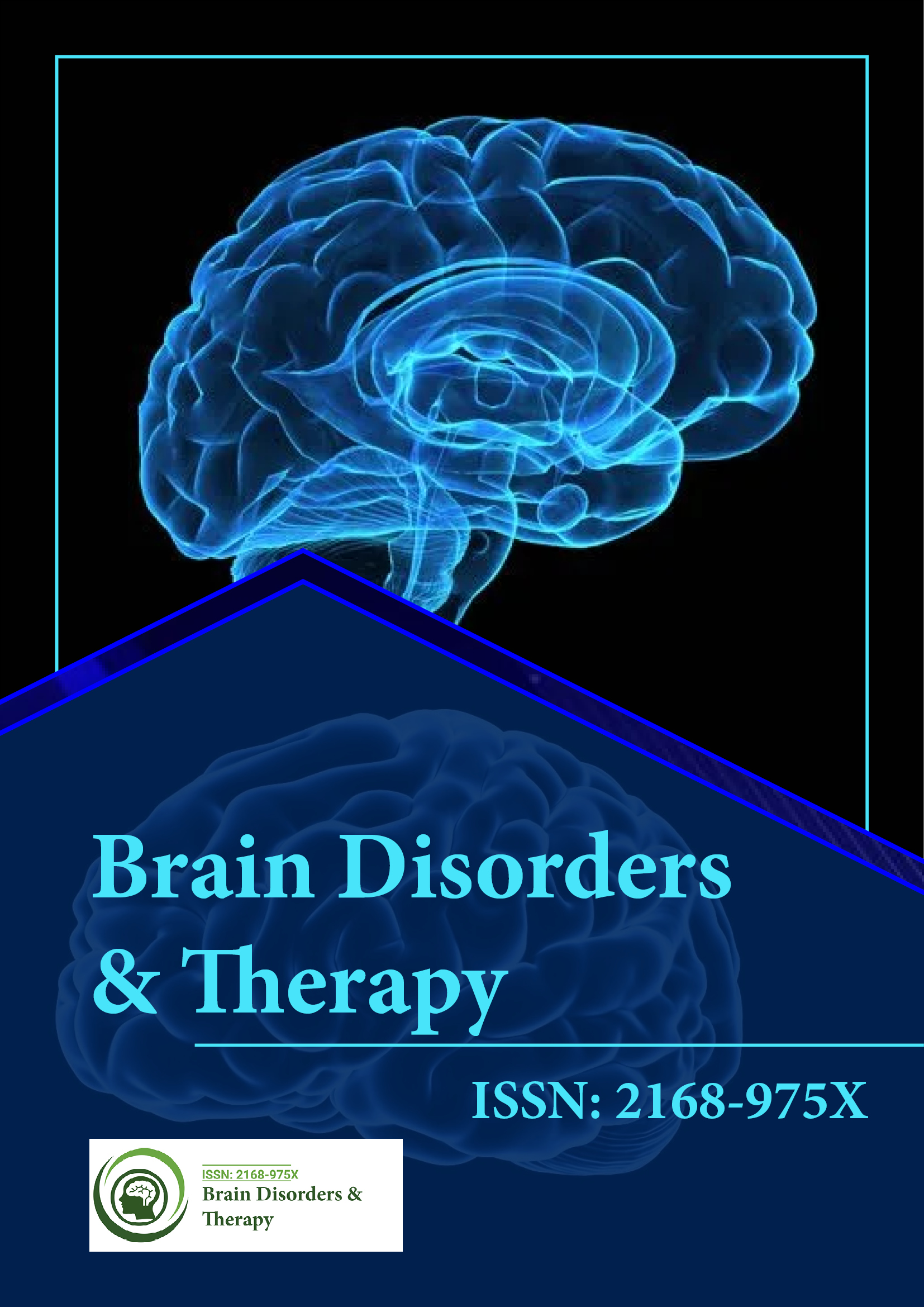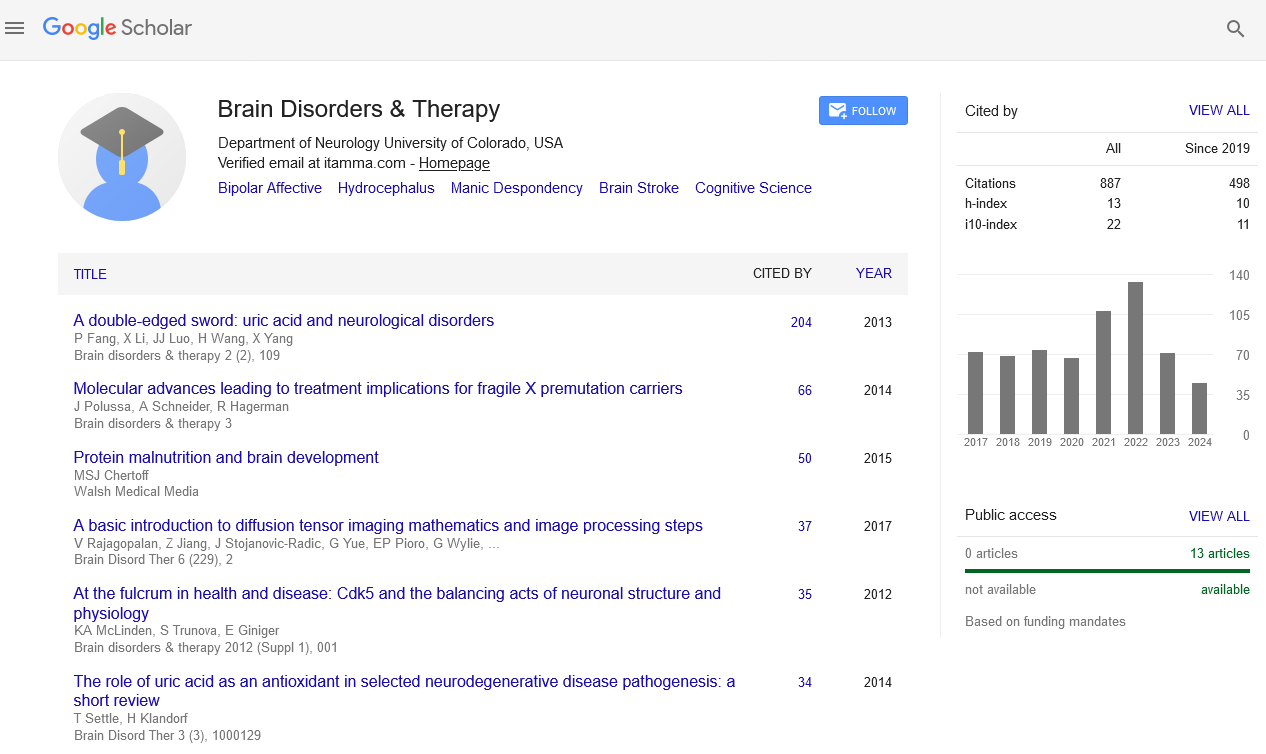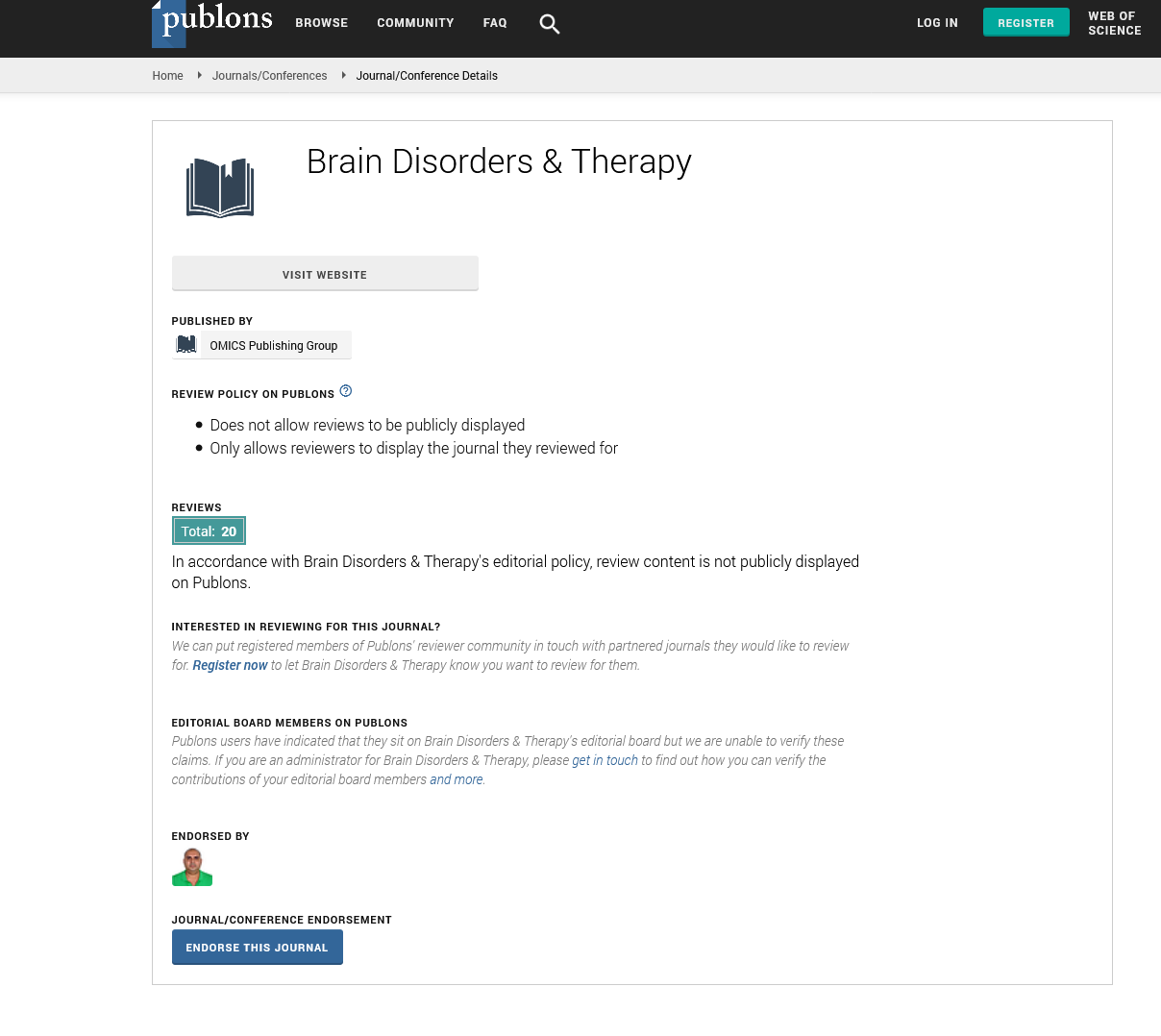Indexed In
- Open J Gate
- Genamics JournalSeek
- JournalTOCs
- RefSeek
- Hamdard University
- EBSCO A-Z
- OCLC- WorldCat
- Publons
- Geneva Foundation for Medical Education and Research
Useful Links
Share This Page
Journal Flyer

Open Access Journals
- Agri and Aquaculture
- Biochemistry
- Bioinformatics & Systems Biology
- Business & Management
- Chemistry
- Clinical Sciences
- Engineering
- Food & Nutrition
- General Science
- Genetics & Molecular Biology
- Immunology & Microbiology
- Medical Sciences
- Neuroscience & Psychology
- Nursing & Health Care
- Pharmaceutical Sciences
Perspective - (2025) Volume 14, Issue 2
Neural Communication Impairment Associated with Glioblastoma Invasion
Rolf Steinlein*Received: 26-May-2025, Manuscript No. BDT-25-29723 ; Editor assigned: 28-May-2025, Pre QC No. BDT-25-29723 (PQ); Reviewed: 11-Jun-2025, QC No. BDT-25-29723 ; Revised: 18-Jun-2025, Manuscript No. BDT-25-29723 (R); Published: 25-Jun-2025, DOI: 10.35248/2168-975X.25.14.303
Description
Glioblastoma Multiforme (GBM) represents the most aggressive and lethal form of primary brain tumor in adults, accounting for around 15% of all intracranial neoplasms. Classified as a grade IV astrocytoma by the World Health Organization, it is characterized by rapid growth, marked heterogeneity and resistance to current therapies. Despite multimodal treatment consisting of maximal safe resection, radiotherapy and temozolomide-based chemotherapy, patient survival rarely exceeds 15 to 18 months and recurrence is nearly universal. One of the major barriers to effective management lies in the highly infiltrative nature of GBM, which extends far beyond the radiologically visible tumor core into adjacent and even remote brain regions. Conventional therapeutic strategies focus largely on cytoreduction of the main tumor mass, but increasing evidence suggests that GBM exerts widespread influence on neural networks, disrupting both structural and functional connectivity. This broader systems-level impact necessitates a paradigm shift in understanding the biology and clinical management of the disease.
Brain connectivity and network disruption
The human brain functions as a highly complex network, where communication between distributed regions underlies cognition, sensorimotor coordination and behavior. GBM disrupts this connectivity not only by physically invading white matter tracts but also by altering patterns of neural synchrony. Studies using Diffusion Tensor Imaging (DTI) have demonstrated degradation of key white matter bundles, including the corpus callosum, uncinate fasciculus and corticospinal tracts. The integrity of these pathways is essential for interhemispheric transfer, language processing and motor control and their disruption correlates strongly with patient symptoms. Beyond structural damage, functional MRI investigations have revealed impaired resting-state connectivity in networks such as the default mode network, executive control circuits and sensorimotor systems. Strikingly, these abnormalities can appear in regions distant from the visible tumor, indicating that GBM acts as a network-level disease rather than a purely localized lesion. This insight highlights why cognitive, emotional and executive dysfunctions often manifest in patients even when the tumor appears confined radiologically.
Molecular interactions and network influence
Beyond mechanical disruption, GBM exerts molecular influences that reshape brain networks. Recent discoveries show that GBM cells form synapse-like structures with neurons, enabling direct electrochemical communication. In these tumor-neuron synapses, neuronal activity can promote tumor proliferation, while tumor cells reciprocally modulate neuronal excitability. This bidirectional interaction effectively integrates GBM into the brain’s circuitry, transforming neural activity into a driver of oncogenesis. In parallel, glial cells such as microglia and astrocytes, which normally regulate synaptic balance and plasticity, are recruited by the tumor to facilitate invasion and suppress immune responses. The altered behavior of these supportive cells further contributes to aberrant network activity, epileptogenesis and cognitive impairment. The recognition that GBM is not merely an invasive lesion but a participant in neural signaling underscores the need for therapeutic approaches that target tumor-brain interactions at the cellular and molecular levels.
Emerging strategies
The current therapeutic paradigm—surgery, radiotherapy and chemotherapy—remains limited by GBM’s diffuse infiltration and capacity to adapt to environmental pressures. Maximal resection often leaves behind microscopic infiltrative cells that seed recurrence. Radiotherapy and temozolomide can extend survival modestly but rarely eradicate the disease, partly because infiltrating cells integrate into normal brain circuits that are difficult to target without causing collateral damage. The recognition of network-level disruption has inspired novel strategies. Functional connectome mapping during preoperative planning can help balance maximal tumor removal with preservation of cognitive networks. Intraoperative brain mapping techniques are increasingly being used not only to identify motor and language areas but also to assess higher-order cognitive circuits. On the molecular side, interventions targeting tumor-neuron synaptic signaling, glutamate release and activity-dependent growth pathways are under exploration.
Immunotherapies and tumor microenvironment modulators
Immunotherapies and tumor microenvironment modulators that prevent glial co-option may also prove beneficial in restoring network stability. These emerging approaches suggest that future treatments may combine cytoreduction with network preservation and modulation, representing a more comprehensive management strategy.
Quality of life considerations
For GBM patients, survival time is only one aspect of disease burden; quality of life, cognitive preservation and functional independence are equally critical. Conventional treatments that prioritize tumor eradication at the cost of cognitive function can lead to prolonged survival with severe disability. By acknowledging the role of brain networks, clinicians can make more informed choices that balance aggressive treatment with the preservation of functional integrity. Neurocognitive assessments, resting-state fMRI and connectomic biomarkers may guide decisions to tailor therapies that optimize both survival and quality of life. Rehabilitation strategies targeting network reorganization, cognitive training and neuromodulation techniques may further support patients in maintaining independence and cognitive resilience, even as disease progresses.
Citation: Steinlein R (2025). Neural Communication Impairment Associated with Glioblastoma Invasion. Brain Disord Ther. 14:303.
Copyright: © 2025 Steinlein R. This is an open-access article distributed under the terms of the Creative Commons Attribution License, which permits unrestricted use, distribution, and reproduction in any medium, provided the original author and source are credited.


